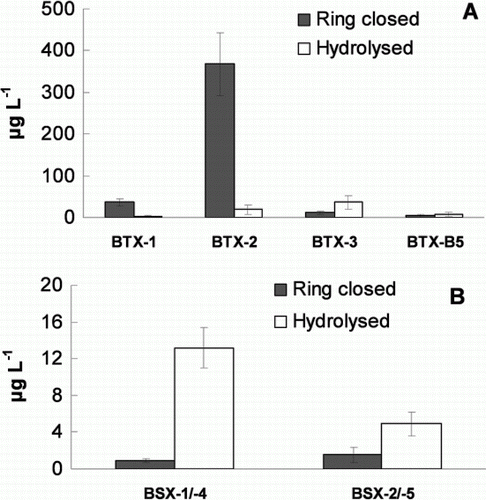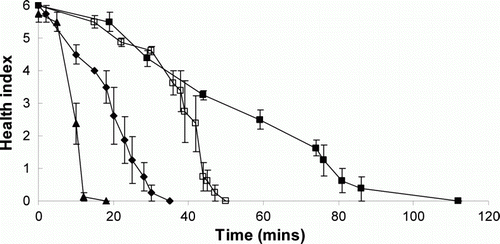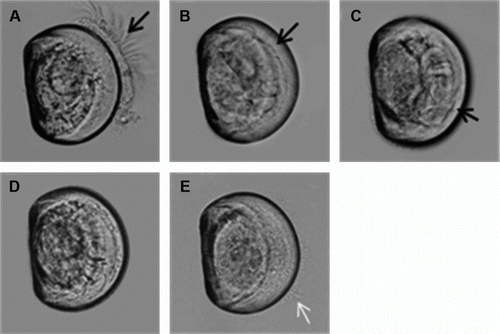Figures & data
Table 1 Toxicity of Karenia species to juvenile Chinook salmon (Oncorhynchus tshawytscha) and juvenile New Zealand snapper (Pagrus auratus).
Table 2 Toxic effects of fresh cultures (19–28 days) and solid phase extraction (SPE)1 extracts of Karenia species and of brevisulcatic acid (BSX)2 toxins, on invertebrate larvae3 (6 days old) over 1–24 h observation.
Figure 1 Phycotoxins produced by Karenia brevis and Karenia brevisulcata—batch carboy cultures grown for 19–20 days and extracted by solid phase extraction for liquid chromatography-mass spectrometry determination; brevisulcatic acid (BSX) concentrations in brevetoxin-2 (BTX-2) response equivalents. A, Karenia brevis. B, Karenia brevisulcata. Columns and error bars depict the mean ± SEM (n = 3); note different scales on y-axes.

Figure 2 Responses of juvenile salmon (Oncorhynchus tshawytscha) to two Karenia species versus time: K. brevis 4.6 × 106 cells L–1 (▴) and K. brevis 0.9×106 cells L-1 (♦), K. brevisulcata 11×106 cells L-1 (□) and K. brevisulcata 1.3×106 cells L-1 (▪).
Notes: The points/bars depict the mean ± SEM (n = 4). Health index: 0, death; 1, extreme loss of balance; 2, leaping; 3, gasping; 4, agitation; 5, slight loss of balance; 6, healthy.

Figure 3 Responses of marine invertebrate larvae (six days old) to Karenia cultures over 24 h. A, Response of paua (Haliotis iris) to K. mikimotoi: control (sterile seawater [×]); 12 × 106 cells L–1 (□) and 118 x 106 cells L–1 (♦). B, GreenshellTM mussel (Perna canaliculus). C, Pacific oyster (Crassostrea gigas). D, Sea slug (Pleurobranchia maculata). E, Sea urchin (Evechinus chloroticus). F, Paua. B–F, Responses of species to K. brevisulcata: control (sterile seawater [×]); 8.4 × 106 cells L-1 (□); 84 × 106 cells L-1 (♦).
Notes: Points and error bars depict the mean ± SEM (n = 3); health scores: 0, death; 1, moribund; 2, severe stress; 3, stress; 4, healthy but larvae static; 5, healthy and larvae swimming; median for 6–10 larvae in each of the triplicate wells.
![Figure 3 Responses of marine invertebrate larvae (six days old) to Karenia cultures over 24 h. A, Response of paua (Haliotis iris) to K. mikimotoi: control (sterile seawater [×]); 12 × 106 cells L–1 (□) and 118 x 106 cells L–1 (♦). B, GreenshellTM mussel (Perna canaliculus). C, Pacific oyster (Crassostrea gigas). D, Sea slug (Pleurobranchia maculata). E, Sea urchin (Evechinus chloroticus). F, Paua. B–F, Responses of species to K. brevisulcata: control (sterile seawater [×]); 8.4 × 106 cells L-1 (□); 84 × 106 cells L-1 (♦). Notes: Points and error bars depict the mean ± SEM (n = 3); health scores: 0, death; 1, moribund; 2, severe stress; 3, stress; 4, healthy but larvae static; 5, healthy and larvae swimming; median for 6–10 larvae in each of the triplicate wells.](/cms/asset/1b0f4b7a-ffa8-4b54-8a52-1f0a1d2c8fb9/tnzm_a_616210_o_f0003g.gif)
Figure 4 GreenshellTM mussel (Perna canaliculus) larvae (six days old) affected by Karenia brevisulcata during exposure over 24 h to 8.4 × 106 cells L–1. A, Healthy and static, score 4. B, Stressed, the velum started to disintegrate, and cilia withdrawn but healthy and moving, score 3. C, Severely stressed, larvae retracted into shell and cilia moving inside shell, score 2. D, Moribund, cilia gone, larvae disintegrating, still some jerking movement, score 1. E, Dead, disintegrated larvae appeared amorphous, decayed and jelly-like, and cells were being discharged from the dead animal, score 0.
Notes: Black arrow in A–C shows cilia and white arrow in E shows leaked tissue.

Table 3 Toxicity of cultures of Karenia species to invertebrate larvae.
Figure 5 Responses of GreenshellTM mussel (Perna canaliculus) larvae to a 56-day K. brevisulcata mass culture without living cells □ and solid phase extraction extracts of 20–30-day Karenia mass cultures: K. mikimotoi (× [85 × 106 cells L–1]), K. brevis (□ [9 × 106 cells L–1]) and K. brevisulcata (♦ [72 × 106 cells L–1]).
Note: Points and error bars depict the mean ± SEM (n = 3).
![Figure 5 Responses of GreenshellTM mussel (Perna canaliculus) larvae to a 56-day K. brevisulcata mass culture without living cells □ and solid phase extraction extracts of 20–30-day Karenia mass cultures: K. mikimotoi (× [85 × 106 cells L–1]), K. brevis (□ [9 × 106 cells L–1]) and K. brevisulcata (♦ [72 × 106 cells L–1]). Note: Points and error bars depict the mean ± SEM (n = 3).](/cms/asset/5b3b2534-22ba-46a9-b38c-0d7ee142c560/tnzm_a_616210_o_f0005g.gif)